Wasat, Delta Geminorum (δ Gem) is the primary component in a triple star system located in the constellation Gemini. The star system has a combined apparent magnitude of 3.53 and lies at a distance of 60.5 light years from Earth. It marks the right arm of Castor, the northern twin of Gemini.
Star system
The Delta Geminorum system is composed of a spectroscopic binary star and a fainter K-type companion. The components in the spectroscopic binary system orbit each other with a period of 2,238.7 days (6.1 years). The orange companion is more than 100 astronomical units away and completes an orbit around the pair every 1,200 years.
The primary component has the stellar classification F0 IV, indicating a subgiant star appearing white in colour. The star has a mass of 1.57 solar masses and a surface temperature of 6,900 K. It is 2.67 times larger than the Sun and about 10 times more luminous. The star is a fast spinner, with a projected rotational velocity of 129.7 km/s. Its estimated age is about 1.6 billion years.
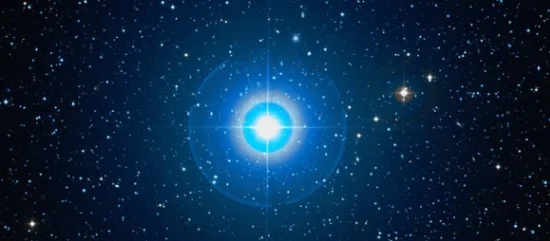
Wasat (Delta Geminorum), image: Wikisky
Facts
With an apparent magnitude of 3.53, Delta Geminorum is the eighth brightest point of light in Gemini and just barely makes the list of the 300 brightest stars in the sky.
Wasat lies only 0.18 degrees south of the ecliptic, the Sun’s apparent path across the sky. Like other stars near the ecliptic, it can be occulted by the Moon and, far less frequently, by planets. It was last occulted by a planet (Saturn) on June 30, 1857. The next occultation (by Venus) will occur on August 12, 2420. Wasat is eclipsed by the Sun around July 10-12 every year. Six months later, in mid-January, it is visible throughout the night.
Pluto was discovered about 0.5 degrees east of Wasat in 1930. American astronomer Clyde Tombaugh, who discovered the dwarf planet, was tasked with finding a possible ninth planet (“Planet X”) in the solar system. He did this by imaging the sky in pairs of photographs and then comparing each pair to see if any of the objects had changed position. He found a possible planet on February 18, 1930. The discovery was confirmed with other photographs and reported on March 1, 1930. Pluto takes 247.94 years to complete an orbit around the Sun and will eventually pass near Wasat again.
Wasat is slowly approaching the Sun and will come within 6.7 light years of the solar system in about 1.1 million years.
Name
The name Wasat (pronunciation: /ˈweɪsət/) comes from the Arabic phrase Wasṭ us-Samā’, meaning “the middle of the sky.” The name itself is Arabic for “middle.” It may be a reference to the star’s position very close to the ecliptic or to its position in the middle of the constellation Gemini.
The name was approved by the International Astronomical Union’s (IAU) Working Group on Star Names (WGSN) on August 21, 2016. It formally applies only to the brightest component, Delta Geminorum Aa.
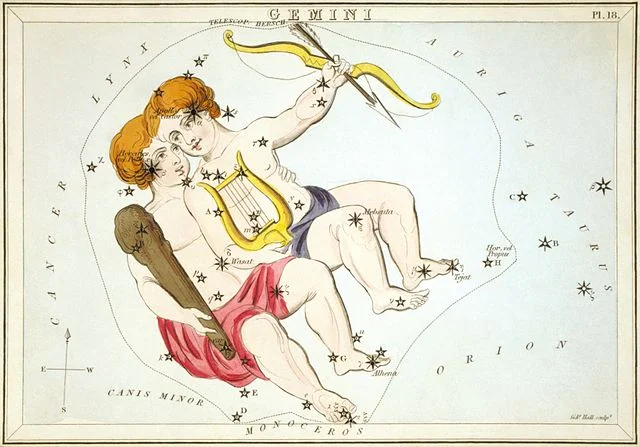
“Gemini”, plate 18 in Urania’s Mirror, 1825
In Chinese astronomy, Wasat is known as 天樽二 (Tiān Zūn èr), the Second Star of Celestial Wine Cup. The name Ta Tsun is derived from the star’s Chinese name. The Celestial Wine Cup is an asterism formed by Wasat with 57 Geminorum and Omega Geminorum. It is part of the Well mansion, one of the southern mansions of the Vermilion Bird.
Location
Wasat is easy to find because it lies in an area full of exceptionally bright stars. It is one of the stars located between the supergiant Betelgeuse in the constellation Orion and Pollux, the brightest star in Gemini. Orion is easy to recognize because its brightest stars form an hourglass figure with the prominent Belt of Orion in the middle. Pollux and Castor can be found near the imaginary line extended from Rigel through Betelgeuse. Wasat appears on the imaginary line drawn from Castor to Sirius, the brightest star in the sky.
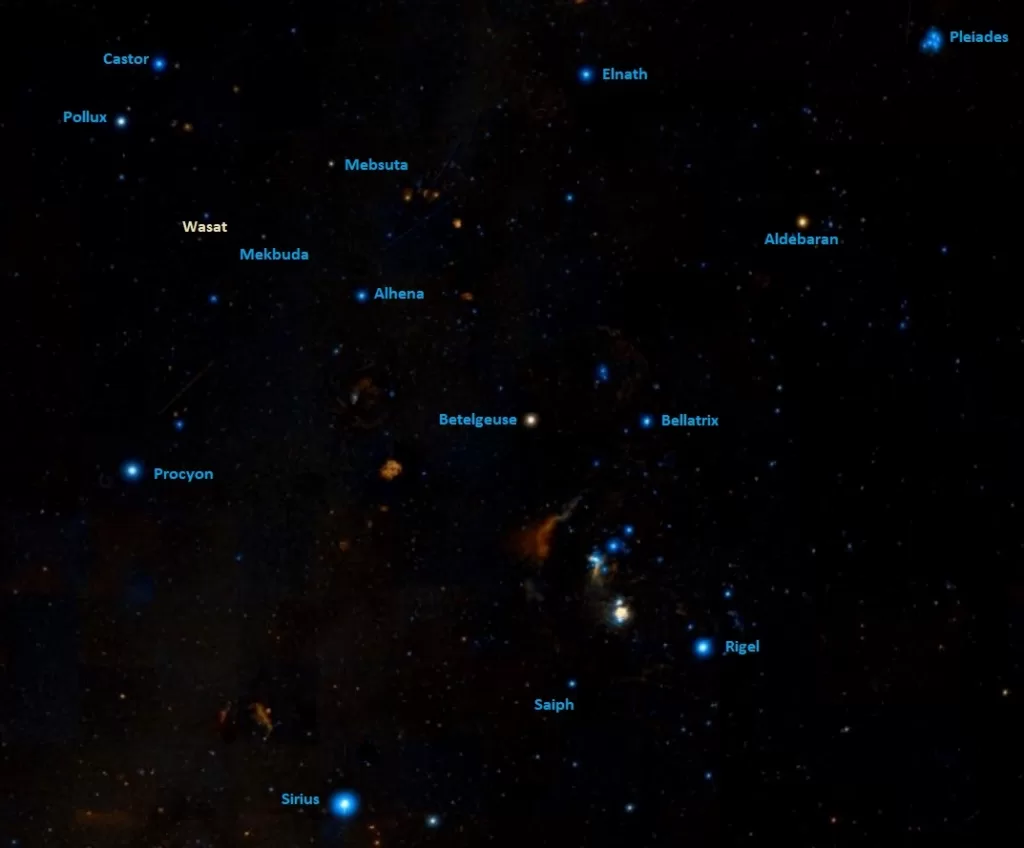
Wasat location, image: Wikisky
Wasat can be used to find the magnitude 12.7 spiral galaxy NGC 2365, which appears in the same field of view as the star.
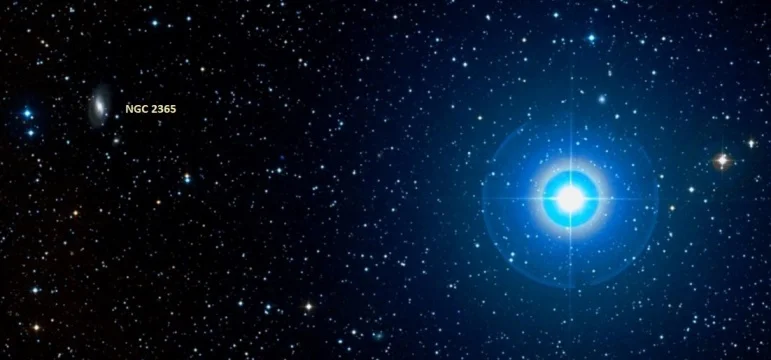
Wasat and NGC 2365, image: Wikisky
The planetary nebula NGC 2392 and the open cluster NGC 2420 are a bit further away. The cluster lies east of Wasat, while the nebula appears southeast of the star.
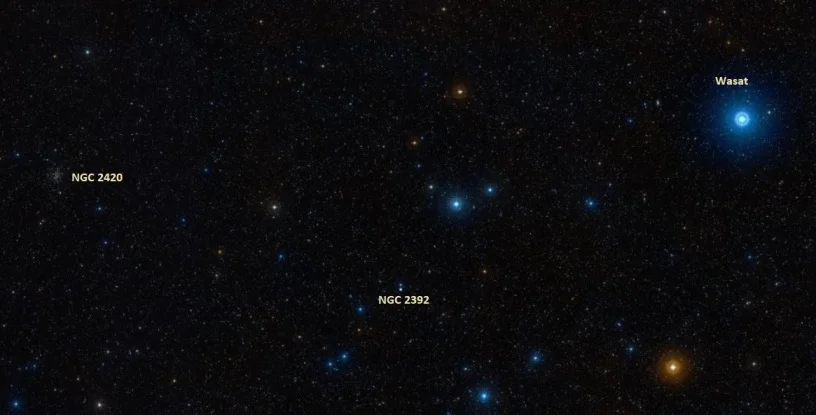
Wasat, NGC 2392 and NGC 2420, image: Wikisky
Constellation
Wasat is located in the northern constellation Gemini. Representing the twins Pollux and Castor in Greek mythology, Gemini has been known to observers since ancient times. Like other zodiac constellations, it was first catalogued by the Greek astronomer Claudius Ptolemy in his Almagest in the 2nd century CE. The constellation’s two brightest stars, Pollux and Castor, mark the heads of the celestial twins.
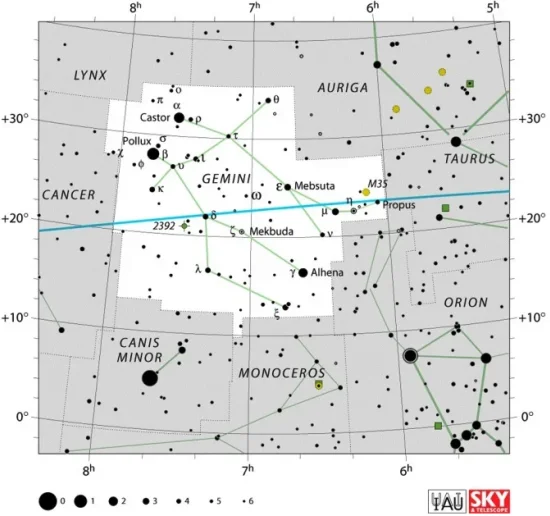
Gemini constellation map by IAU and Sky&Telescope magazine
Gemini is the 30th largest constellation in the sky, occupying an area of 514 square degrees. It contains many notable stars, including the orange giant Pollux, the multiple star system Alpha Geminorum (Castor), the yellow supergiant Mebsuta, the variable yellow-white supergiant Mekbuda, the neutron star Geminga, and the dwarf nova U Geminorum.
Gemini is also home to several well-known deep sky objects: the bright open clusters Messier 35 and NGC 2129, the planetary nebulae NGC 2392 and Sharpless 2-274 (the Medusa Nebula), and the supernova remnant IC 443 (the Jellyfish Nebula).
The best time of year to observe the stars and deep sky objects in Gemini is during the month of February, when the constellation is prominent in the evening sky. The entire constellation is visible from locations between the latitudes 90° N and 60° S.
The 10 brightest stars in Gemini are Pollux (Beta Gem, mag. 1.14), Castor A (Alpha Gem A, mag. 1.93), Alhena (Gamma Gem, mag. 1.9), Tejat (Mu Gem, mag. 2.86), Castor B (Alpha Gem B, mag. 2.97), Mebsuta (Epsilon Gem, mag. 3.06), Propus (Eta Gem A, mag. 3.15 – 3.90), Alzirr (Xi Gem, mag. 3.35), Wasat (Delta Gem, mag 3.53), and Kappa Geminorum (mag. 3.568).
Wasat – Delta Geminorum
| Spectral class | F0 IV |
| U-B colour index | +0.04 |
| B-V colour index | +0.34 |
| Apparent magnitude | 3.53 |
| Angular size | 0.093 arcminutes |
| Absolute magnitude | 1.95 |
| Distance | 60.5 ± 0.7 light years (18.5 ± 0.2 parsecs) |
| Parallax | 53.94 ± 0.66 mas |
| Radial velocity | +4.1 ± 2 km/s |
| Proper motion | RA: -15.13 ± 0.85 mas/yr |
| Dec.: -9.79 ± 0.47 mas/yr | |
| Mass | 1.57 M☉ |
| Luminosity | 10.147 L☉ |
| Radius | 2.67 R☉ |
| Temperature | 6,900 K |
| Metallicity | -0.26 dex |
| Age | 1.6 billion years |
| Rotational velocity | 129.7 km/s |
| Constellation | Gemini |
| Right ascension | 07h 20m 07.3797829s |
| Declination | +21° 58′ 56.337741″ |
| Names and designations | Wasat, Delta Geminorum, δ Gem, 55 Geminorum, HD 56986, HR 2777, HIP 35550, SAO 79294, FK5 279, BD+22° 1645, PPM 97380, GC 9755, GCRV 4854, AG+22 862, Gl 271, JP11 1533, IRAS 07171+2204, 2MASS J07200736+2158561, PLX 1718, UBV 7099, TYC 1359-2672-1, Gaia DR2 866177431953646464, ADS 5983, CCDM J07201+2159A, WDS J07201+2159A |